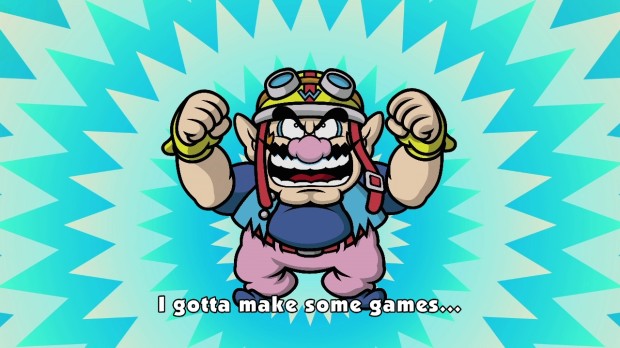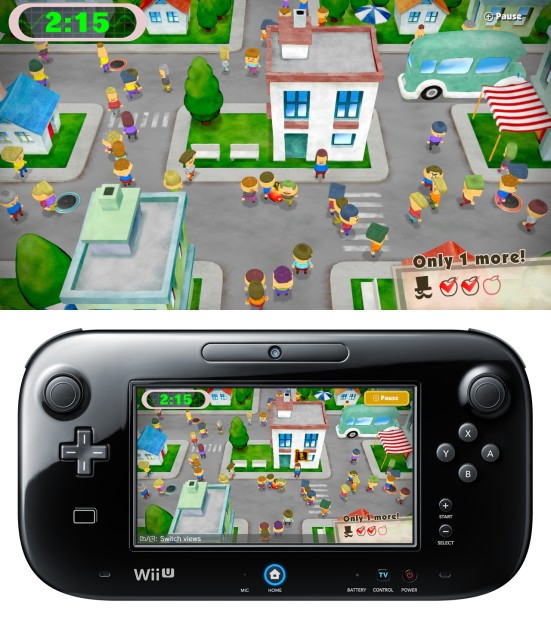Game & Wario Review
Game & Wario is a strange beast to play, for the main reason that rather than operating as one game, it takes on the guise of more than ten different options. Most of these games are in turn comprised of a series of stages, which last only a couple of minutes each, and usually serve as a way to show off a particular facet of the Wii U and its companion Gamepad. In fact, Game & Wario does such a good job of advertising the wide range of functions that the Wii U can perform that it boggles the mind that Nintendo Land, and not Game & Wario, comes bundled with the Deluxe Edition of the console.
Game & Wario doesn’t really contain much story to speak of, and almost seems to revel in the fact that it boils videogaming down to its simplest form: a mixture of quick reflexes, sharp thinking and pattern recognition that can be found in almost any game, but here it comes without the graphical or narrative padding that often surrounds it in AAA titles. Unfortunately, this can mean that some of the games that are present within Game & Wario, such as ‘Kung-Fu’ or ‘Ski’, feel as if they’re lacking in depth and therefore incentive for the player to play them more than a couple of times. On the other hand, though, a number of the options, including gems such as ‘Gamer’ (which has you watching both the gamepad and the TV screen as you attempt to play games past your bedtime) and ‘Design’ (which tasks you with drawing out blueprints for a robot) are unlike anything that you’ll play elsewhere, even if they don’t keep you hanging around for that long.
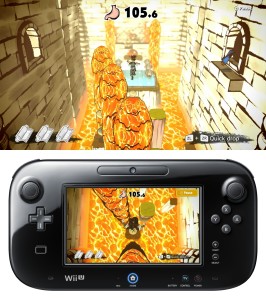 The various games in Game & Wario are unlocked one at a time, starting with ‘Arrow’. Once you’ve completed the first stage of ‘Arrow’, the second game ‘Shutter’ becomes available, and once you complete the first stage of that, ‘Ski’ is unlocked, and so on and so forth. Whilst you need to play each game at least once to unlock the remainder of the games, each individual option often comes with a number of levels within it that increase in difficulty. ‘Arrow’, for example, ups the enemy count with each successive level, and even introduces new enemy types each time, making for a fresh experience from one level to the next. Other games, such as ‘Patchwork’, contain enough levels that they could have arguably been removed from Game & Wario and released as a standalone title, particularly now with the increasing popularity of downloadable releases on Nintendo consoles.
The various games in Game & Wario are unlocked one at a time, starting with ‘Arrow’. Once you’ve completed the first stage of ‘Arrow’, the second game ‘Shutter’ becomes available, and once you complete the first stage of that, ‘Ski’ is unlocked, and so on and so forth. Whilst you need to play each game at least once to unlock the remainder of the games, each individual option often comes with a number of levels within it that increase in difficulty. ‘Arrow’, for example, ups the enemy count with each successive level, and even introduces new enemy types each time, making for a fresh experience from one level to the next. Other games, such as ‘Patchwork’, contain enough levels that they could have arguably been removed from Game & Wario and released as a standalone title, particularly now with the increasing popularity of downloadable releases on Nintendo consoles.
Perhaps the greatest strength of Game & Wario is that even though some of the games feel a little less worthy in terms of how much time you’ll dedicate to them than others, each title attempts to do something different, meaning that you don’t really get the same experience from one game to the next. Take the first four games that you unlock, for example. In order, they are ‘Arrow’, ‘Shutter’, ‘Ski’ and ‘Patchwork’. Each uses a different control scheme, requiring the gamepad to be held in a different manner, and each feels like its own unique experience because of it. ‘Arrow’ has you holding the gamepad horizontally, using the touchscreen to draw back arrows while you aim the gamepad at enemies on the screen. ‘Ski’ requires you to hold the pad vertically, with the short ends at the top and bottom, and you twist the pad left and right in order to turn your avatar. ‘Shutter’ turns the gamepad into a camera, in much the same way as LEGO City Undercover, and you use the screen as you would the screen on a digital camera. ‘Patchwork’, on the other hand, requires the use of the stylus to drag shapes around on the touchscreen as you fill in quasi-jigsaw puzzles.
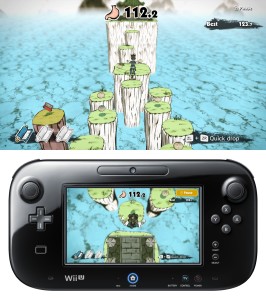 With 12 different games to choose from in single-player, combined with an extra four in multi-player, there appears to be a lot of content on offer within Game & Wario. However, much of the content operates almost as a technical demo, and once you dig below the surface you realise that there isn’t a lot here to drag you back after you’ve played the game a couple of times. Game & Wario works in a similar vein to Wii Sports, and almost follows the biggest draw on the Wii a little too well. This is an ideal game to pull off the shelf when you have friends or family over, using the various games to show off the capabilities and unique features of the Wii U, but once your visitors have gone home, chances are Game & Wario will go back onto the shelf ready for your next soiree.
With 12 different games to choose from in single-player, combined with an extra four in multi-player, there appears to be a lot of content on offer within Game & Wario. However, much of the content operates almost as a technical demo, and once you dig below the surface you realise that there isn’t a lot here to drag you back after you’ve played the game a couple of times. Game & Wario works in a similar vein to Wii Sports, and almost follows the biggest draw on the Wii a little too well. This is an ideal game to pull off the shelf when you have friends or family over, using the various games to show off the capabilities and unique features of the Wii U, but once your visitors have gone home, chances are Game & Wario will go back onto the shelf ready for your next soiree.
It’s a bit of shame, because Game & Wario does try to encourage you to hang around for a little longer than you would otherwise, mainly with the use of its collectibles system. How this works is thus: each time you complete a stage for the first time, or when you beat a highscore, you are awarded a coin. Taking this to the capsule machine (think Shenmue) gives you the opportunity to unlock one of 240 collectibles, which run from the mundane (such as character bios and soundtrack clips) to the odd (such as a device which takes a photo of your face and covers it in virtual kisses), to the inspirational (such as a recipe (with pictures) instructing the player how to make a bento box that resembles Wario). It’s a credit to the game that you’re never quite sure what you’re going to find in an individual capsule, but the extras don’t do quite enough to create a desire to collect them all, with most of them performing a novelty role, drawing a “Huh, that’s kind of cool” from the player, before quickly being forgotten and left on their virtual shelf for all eternity.
Whilst most of the games within Game & Wario are too small and simplistic to suffer from any real game-breaking issues, it would be false to say that you won’t run into problems while playing through the various modes. The most common frustration experienced within the game came from those modes that require you to use the Wii U’s gamepad for precision aiming, such as ‘Arrow’ and ‘Pirates’, as quite often the tracking recalibrates itself midgame, meaning that you have to aim way off to the right or left, requiring you to look away from the TV, just to get the crosshairs on-screen to centre themselves. Other issues are more aesthetic in nature, and spring from the fact that for a game that offers so little in way of depth, there is a lot of repetitiveness in terms of environments and visuals. Again, ‘Arrow’ is a culprit for this, but ‘Shutter’ is another prime example. Both of these modes contain only five stages, yet ‘Arrow’ presents players with the same backdrop each time, just with a different set of colours to represent the different seasons. ‘Shutter’ is a little better, but still only manages three different environments over its five different levels (i.e. a cityscape, a theatre, and a train ride). It’s well understood that Game & Wario isn’t intended to be a graphical powerhouse, but a little more variety wouldn’t go amiss.
In terms of aesthetics on a basic level, Game & Wario does an adequate, if unremarkable, job. The game takes on the appearance of a thickly-bordered animation, with a bright and inoffensive colour palette, and the music is catchy if not particularly memorable. Characters are well-designed and humorous, and the B-movie style posters that advertise each individual game contain perhaps the most character of any individual aspect of Game & Wario. There’s no voice-acting within the main game (although there is a small amount in some of the collectibles), which is unfortunate, as some real fun could have been had there, but seeing as there isn’t really any story to speak of, it wouldn’t really have served much purpose had it been present.
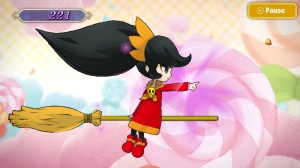 As mentioned previously, Game & Wario would have been a perfect title to bundle in with new Wii U consoles, and could have perhaps worked a second miracle for Nintendo in the same way that Wii Sports managed for the Wii. As it is, with Game & Wario as a separate retail release, it might just mean that it will fly under a lot of potential customers’ radars, and that is a great shame for a title that tries to do so much different from everything else on the shelf. Though the experience itself isn’t particularly deep, (and you may find that the game spends most of its life sitting on the shelf as you wait for the perfect opportunity to bring it out when friends are over) when the moment does come to dig out Game & Wario, you’re almost guaranteed to have a great time. The game does have a couple of small issues, but nothing that takes away from the experience as a whole too much, and these problems can be largely overlooked when it is considered just how well Game & Wario conveys the strengths of the Wii U as a console – a task which not too many games as of yet have completed.
As mentioned previously, Game & Wario would have been a perfect title to bundle in with new Wii U consoles, and could have perhaps worked a second miracle for Nintendo in the same way that Wii Sports managed for the Wii. As it is, with Game & Wario as a separate retail release, it might just mean that it will fly under a lot of potential customers’ radars, and that is a great shame for a title that tries to do so much different from everything else on the shelf. Though the experience itself isn’t particularly deep, (and you may find that the game spends most of its life sitting on the shelf as you wait for the perfect opportunity to bring it out when friends are over) when the moment does come to dig out Game & Wario, you’re almost guaranteed to have a great time. The game does have a couple of small issues, but nothing that takes away from the experience as a whole too much, and these problems can be largely overlooked when it is considered just how well Game & Wario conveys the strengths of the Wii U as a console – a task which not too many games as of yet have completed.
About This Post
